#lossless compression
Text
#PNG vs JPEG#Image File Formats Comparison#Image Compression#Lossless Compression#Lossy Compression#Graphic Design#Image Quality#Digital Images#Image Format Selection#Visual Content#Image Optimization#Web Graphics#File Size Reduction#Digital Photography#Multimedia Formats#Transparency in Images#Visual Effects#Image Loading Speed#Image Compatibility#Format Choice
0 notes
Text
Just Arrived: The Sony a7 IV Got an Extra AF Boost
But don't try the small lossless compressed just yet...
The Sony a7 IV just got a refresh, thanks to new firmware. The latest software for the camera, firmware 1.10, improves the eye AF and adds multiple sizes of lossless compression. But, the software isn’t exactly new. Sony released it earlier this year, then pulled it back because of a bug. Now, the firmware update is back.
(more…)

View On WordPress
#autofocus#Eye AF#firmware update#lossless compression#Photography#sony#sony a7 iv#sony a7 iv firmware
0 notes
Text
it’s so crazy when you find people who you can talk to in a way where the discussion feels like passing your ideas through a sieve that makes them sharper and more refined. for me 90% of the conversations i’m in can end up feeling like they’re doing the opposite, so it’s something really special
#text tag#i think i compared it to lossless vs lossy compression before but that’s not quite right given ofc the other person adds something too
6 notes
·
View notes
Text
me watching a low-resolution stream: wow, lossy compression... just like in Exordia
#exordia#seth dickinson#I guess exordia is mostly about lossless compression but yknow related concepts
5 notes
·
View notes
Text
convering all my behind the scene's JPG/JPEGs to PNGs so people can download whatever BTS they want without damaging the quality ^_^
#fun fact: jpg/jpegs rot over time#because of the slight compression each time#but PNGs are lossless so it doesnt lose any quality!
3 notes
·
View notes
Text




I made these rq for the about, feel free to use them if any of yall want :)
#no credit is needed theyre straight from sonic battle#ill probably make some more gifs honestly i really love the sonic battle animations but theres like no gifs of them anywhere#ack tumblrs compressing them a little.... i promise theyre not as blurry as they look blown up#the top ones are the og little size and shooould be lossless while the bottom two were resized
3 notes
·
View notes
Text
i think i will hunt down and kill the cunt who invented .webp format
#so annoying trying to snag images for pure ref#only to get my shit fucked by google over and over#hey google how about i level your headquarters#how's that for lossless compression bitch
5 notes
·
View notes
Text
are there any lossy compression algorithms designed so that.... how do i describe it
D(C(D(C(F)))) = D(C(F))
D = decompress, C = compress, F = file
#jadeposting#i guess you would do a reduction transformation and then apply a lossless compression algorithm...
1 note
·
View note
Text
0 notes
Text
My whole life has been a lie! This whole time I've been rocking WebP formatted photos on my Jellyfin server, they've been...
L O S S Y
Devastated. Kicking. Screaming. Crying.
I thought Shutter Encoder could detect when a PNG was input and encode the WebP file properly, but using Google's "webpinfo" command, I confirmed that all my formerly PNG photos are now lossy, so I guess it can't.
Fortunately, however, I found a semi-GUI macOS app which can batch convert photos into JPEG XL, and using some custom workflow rules, it CAN determine whether a photo needs lossy or lossless conversion. Looks like my data hoarding of the original formats is paying off, and I'm moving to JXL sooner than I expected.
#melodramatic#rambles#photos#jellyfin#server#png#webp#jxl#jpeg#jpeg xl#lossy#lossless#compression#data#data archiving#data compression#shutter encoder
1 note
·
View note
Quote
Imagine what it would look like if ChatGPT were a lossless algorithm. If that were the case, it would always answer questions by providing a verbatim quote from a relevant Web page. We would probably regard the software as only a slight improvement over a conventional search engine, and be less impressed by it. The fact that ChatGPT rephrases material from the Web instead of quoting it word for word makes it seem like a student expressing ideas in her own words, rather than simply regurgitating what she’s read; it creates the illusion that ChatGPT understands the material. In human students, rote memorization isn’t an indicator of genuine learning, so ChatGPT’s inability to produce exact quotes from Web pages is precisely what makes us think that it has learned something. When we’re dealing with sequences of words, lossy compression looks smarter than lossless compression.
Ted Chiang’s essay about ChatGPT is required reading
10K notes
·
View notes
Text
#WebP#Image format#Compression#Overview#Explained#How it works#Comparison#WebP vs other formats#Lossless#Lossy#Browser support#Efficiency#Quality#WebP advantages
0 notes
Text
The Sony A1 Keeps Getting Better
Firmware 1.30 improves eye-AF.
The flagship Sony a1 remains at the top of many photographers’ wishlists. Its initial debut was met with excitement and awe. It was apparent that Sony had returned to its quest for innovation. On paper, the tech specs were a marvel. In real-world tests, the a1 performed as everyone hoped it would. How should it be improved?
(more…)

View On WordPress
#Animal Detection#auto white balance#Eye AF#face detection#firmware update#lossless compression#sony a1#sony a1 firmware update#Sony firmware v1.30#stability
0 notes
Link
0 notes
Text
Oh my god. You guys. Listen!!!
.webp is fine.
The amount of misinformation I see going around about this totally benign image format is so bizarre. Particularly weird is how much it circulates among artists specifically. Listen. Look at me. Artist to artist: It's just a file format. It's not DRM, it wasn't invented to make your life inconvenient, and there is in fact software for opening it and converting it offline. Support for the format in image editing software is basically nonexistent, yes. That's because that isn't really what it's for. It's in the name: WEBP is for the web.
Speaking as an artist who maintains a website, WEBP is a godsend. That's because it lets you get way, way, way better quality than jpeg in a way, way smaller file. "But who likes JPEG anyway? The compression artifacts make my skin crawl!" Okay, cool: WEBP can also save lossless files just like PNG, except lossless WEBPs are (again) way, way, way smaller than PNGs. If you're an artist who wants control over how your art is presented to people online, if you want to really fine-tune the tradeoff between filesize and quality, WEBP is unquestionably the best format available right now. It is not even close.
It is a shame that offline support for the format is so spotty. But that's not WEBP's fault; WEBP is open source and the code for reading and writing them is freely available. We're just in a transitional period where the developers of your preferred image viewing/editing software haven't caught up yet.
#text#I Don't Know Who Needs To Read This But#seriously the image galleries on my site load SO fast and look SO crisp
805 notes
·
View notes
Text

A few people took exception to calling my car's CD player useless.
I actually think it is great there are a few holdouts still using CDs.
CDs are truly one of the most perfect media ever created.
And I can prove that mathematically.
Some will say vinyl is superior. And as much as I love records, the audio quality is preferred, not better. People have a *preference* for how vinyl sounds, but it still leaves out audio information and has noise and artifacts caused by the mechanics of the turntable and an imperfect manufacturing process.
In fact, the lesser audio quality is exactly what people enjoy. It has a warmth and comfortably compressed dynamic range that is not fatiguing over long listening sessions. It's like choosing a nice fire over a 100% efficient space heater.
But if you want perfect audio quality that does not exceed the limits of human hearing, compact discs are where it's at.
It all has to do with Dr. Harry Nyquist and his Nyquist-Shannon Theorem. (Sometimes Shannon gets left out and it is just called the Nyquist Theorem.)
The simple version is he figured out how much something needs to be sampled in order to not lose any information. As long as you sample something at a frequency greater than or equal to twice per cycle, you will have a lossless... whatever.
In this case, a lossless audio recording.
So the range of human hearing is about 20 Hz to 20 kHz. That's the lowest and highest frequencies we can perceive. The scientists creating CD audio figured they'd do 22 kHz for some overhead and then you double that to get 44 kHz. (Technically it was 44.1 kHz.)

You can imagine the smooth curvy line as an analog recording. No gaps. No information loss.
The black squares are digital samples recorded over a period of time. You can see there are gaps between those black squares. A tiny bit of time passes between the squares where nothing is sampled. INFORMATION LOSS! NOOOOO!
Clearly the vinyl nerds are correct and digital is inferior, right? You are going to get the dreaded... STAIR STEPS!
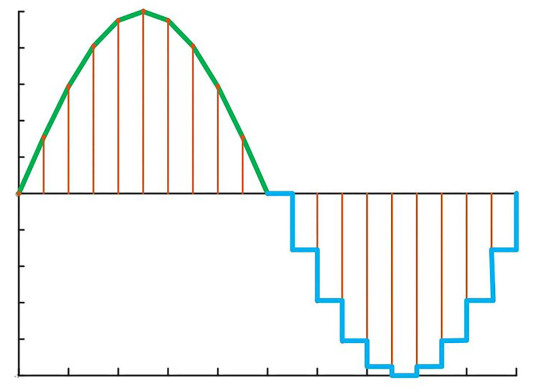
Not so fast, bucko!
By getting enough samples over a period of time, you can use math to infer that smooth sloping line connecting those individual samples. So the digital recording also has no information lost once it is converted back to analog and played through your speakers.
This connecting of dots is called "interpolation."
You could take the curvy analog, convert it to digital, get the same black squares, and then interpolate the black squares back into analog and get the same curvy line. It goes back and forth perfectly. And this is all verifiable with an oscilloscope.
NEAT!
Then of course you need a good dynamic range--the spectrum of quiet to loud. Anything above 85 decibels will damage your hearing, so they went with a 16-bit depth which covers roughly 100 dB. Again, giving them a little overhead for death metal and overzealous trumpet players.
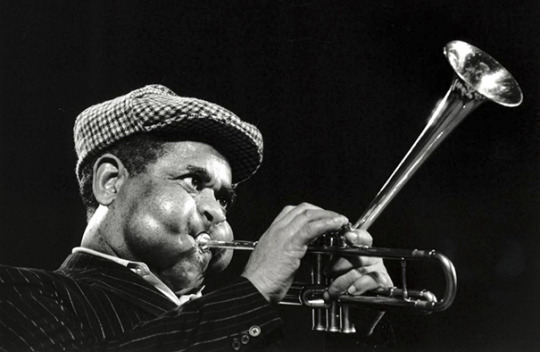
And the final component is data bandwidth or "bitrate" usually measured in kilobits per second. This is how much data is read every second. The 1s and 0s of it all. The bitrate of a CD is calculated by multiplying 44,100 samples per second per channel by 16 bits per sample and then multiplying by 2 channels. After all that mathing is math'd, you get a perfectly uncompressed 1,411 kbps.
So you've got all the frequencies you could ever hear combined with as much volume as your ears can stand with a bit rate that will give you no loss of data.
The *perfect* audio quality all encoded into little microscopic pits.
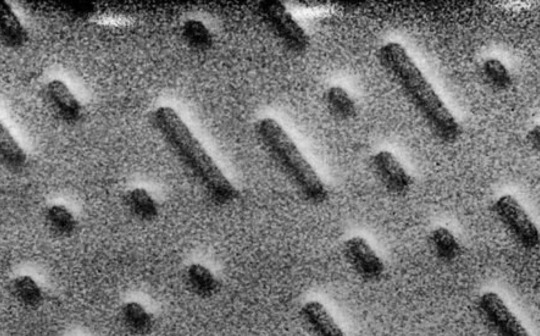
Now you may be asking, "Why do I see "24/96" or "24/192" advertised on fancy audio equipment and high quality streaming platforms like Tidal? Aren't 24 bits better? Isn't 96 kHz MORE than 44.1 kHz?"
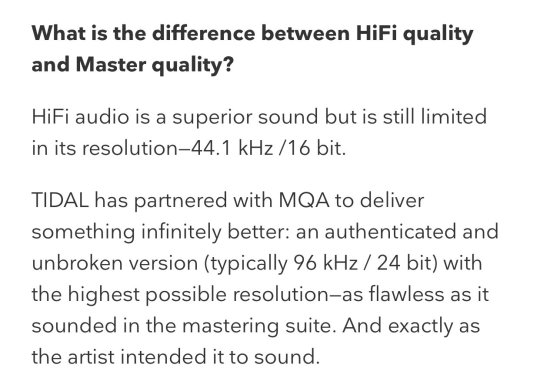
Dr. Nyquist might say... this is some bullshit.
This confusion comes from the fact that recording quality and playback quality are two different animals. This misunderstanding happens with video and photo quality as well. Recording in 6K will give you a sharper picture even if your final playback quality is 4K. You can get bad pixels and noise and stray photons that do not contribute to the detail in the video. By giving yourself overhead you can ensure you hit the desired quality target.
And recording at 24 bits and 96 or 192 kHz, you get a higher resolution to edit and master with, but it is only advantageous to the computer software... not the human ear.
From a photographer's perspective, I relate to it like this...
If I have more megapixels and more colors and more dynamic range I have more leeway when editing my photos. If you try to push a low quality photo in the edit, it has this tendency to fall apart. You can get ugly color banding and harsh contrast and sharpening artifacts. By capturing more quality than you need in the finished product, you can process the photo much more dramatically before it deteriorates and loses integrity.
Audio and video are the same way.
So let's say you have a metal singer that screams at the microphone as loud as possible from 2 inches away.

At 16 bits they may surpass that 100 decibel dynamic range and distort the recording. But if you record in 24 bits, you get 144 dB to play with. Or you can even do 32 bits and get 1500 dB--a volume that no human voice could ever surpass. It guarantees a clean, distortion free recording, but 32 bits would be pointless for human listening.
The same is true with the sample rate. Having a higher resolution allows you to zoom into waveforms and adjust things to an extremely granular level. You can do precise timings, tiny pitch adjustments, apply loads of digital effects, and just have more room for audio activities without degrading the sound quality.
But outputting 192,000 of those black squares is going to interpolate the exact same smooth curvy line as 44,100 when it is played through speakers.

The oscilloscope knows what I'm talking about.
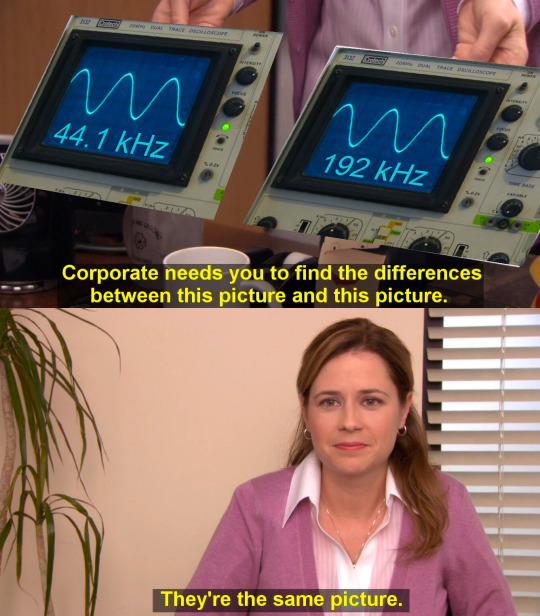
Now I am about to reveal a secret that no audiophile who has invested in a $115,000 high resolution 32 bit/3,072 kHz DAC wants to acknowledge...
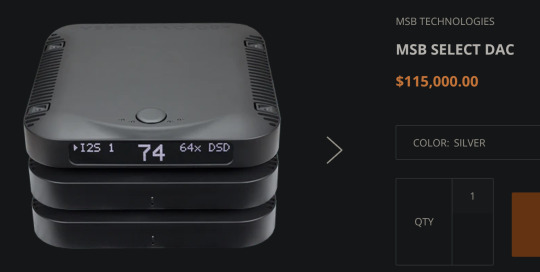
The master recording is always more important than the playback quality.
If you have a high quality source it will sound great even in a highly compressed MP3. Just like the 6K video is sharper on the 4K TV. And the high megapixel photo looks better in an Instagram post.
If the source is good, the media will be good.
And since high resolution audio services often seek out the best masters available before encoding their playback files, it gives many people the illusion they are getting better sound quality due to the boosted specs.
When in reality, it was just a better copy of the original recording.
According to Nyquist, your human ears are not computers and all you need is double the frequency to hear perfect sound with no loss of information. So anything above 16 bit/44.1 kHz/1411 kbps and you are just wasting bandwidth on a server.
And I don't want to hear anything about "stair stepping."
IT'S MATH.
Your ears aren't better than math, okay?
If you don't believe in math, then you and Jack White can sit in the naughty math corner with his bespoke overpriced vinyl pressings.

I will say, there is a gap between your standard music streaming service like Spotify and your bullshit audiophile service like Tidal.
Free Spotify uses heavily compressed files. Which means the bitrate is quite low and there can be information loss. Or "lossy" compression. Modern compression is actually pretty amazing, but I'm afraid anything below 320 kbps may cause some songs to not sound as intended.
Depending on the content, some songs are more suited to compression than others. And even with premium Spotify, they cap songs at 320 kbps which still may not be enough for busier, harder-to-compress songs.
Also, I don't know if Spotify cares about getting the best quality master for a given song. Which, again, is the most important aspect of sound quality.
But services like Tidal waste bandwidth with their super specs and that isn't great for the environment. What I'd love to see is a company that makes their best effort to seek out high quality masters, and encodes their files at 16 bit/44 kHz with a lossless variable bit rate compression. Variable bit rate or "VBR" will do more compression during simpler parts of the audio and less compression during more complex parts. It's smart compression, basically. And as long as you use a high enough bitrate to achieve lossless compression, the sound quality will be the same as if there is no compression at all. So you still get smaller file sizes that use less bandwidth and have a smaller environmental impact.
That would be a streaming service I would consider paying for. Especially if they put great effort into getting high quality original recordings for their content.
In conclusion... if you are still using CDs you don't need to worry about audio quality. You're all set. There is a sort of beauty in what the audio scientists who created compact discs did. They figured out the limits of human audio perception and created a format that just slightly exceeded that. No "bigger number is better" marketing. No audiophile bullshit.
They said, "Here is what you need and nothing more."
They made a perfect thing and they should be proud of that.
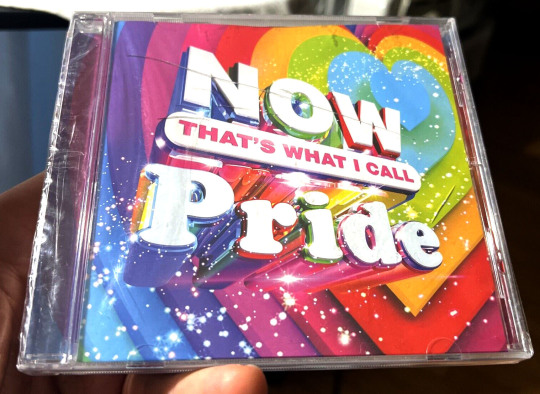
434 notes
·
View notes